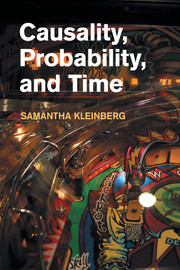7 - Case Studies
Published online by Cambridge University Press: 05 December 2012
Summary
Thus far, I have evaluated the approach developed here conceptually, but the goal is to apply the methods to actual data. Before applying a new approach to a new domain, though, it must first be evaluated on datasets where the true relationships are known. This chapter discusses two types of applications: validation on simulated neuronal and financial time series (to determine how well the algorithms can recover known causes) and experimentation on financial time series (to discover novel relationships).
Simulated Neural Spike Trains
We begin our study of applications with synthetically generated neural spike trains. The underlying relationships here are simple (one neuron causing another to fire in some predefined window of time), but the data allow validation of the algorithms for inferring relationships and their timing, and comparison against other methods. There has been much recent work on determining the connectivity between neurons by applying causal inference methods to spike train measurements (Brown et al., 2004; Hesse et al., 2003; Kamiński et al., 2001) but timing information is a central part of the causal relationships, so it will be useful to compare the approach to others that include this information to varying extents. I begin with a comparison where all algorithms are provided with the known times before examining how well the approach can recover these timings without such prior knowledge.
Synthetic MEA data
The data were created to mimic multi-neuronal electrode array (MEA) experiments, in which neuron firings may be tracked over a period of time. Data was generated for five different structures, with neurons denoted by the 26 characters of the English alphabet. Each dataset contained 100,000 firings generated using one of the five structures plus a degree of noise (this is a parameter that was varied).
- Type
- Chapter
- Information
- Causality, Probability, and Time , pp. 183 - 205Publisher: Cambridge University PressPrint publication year: 2012

